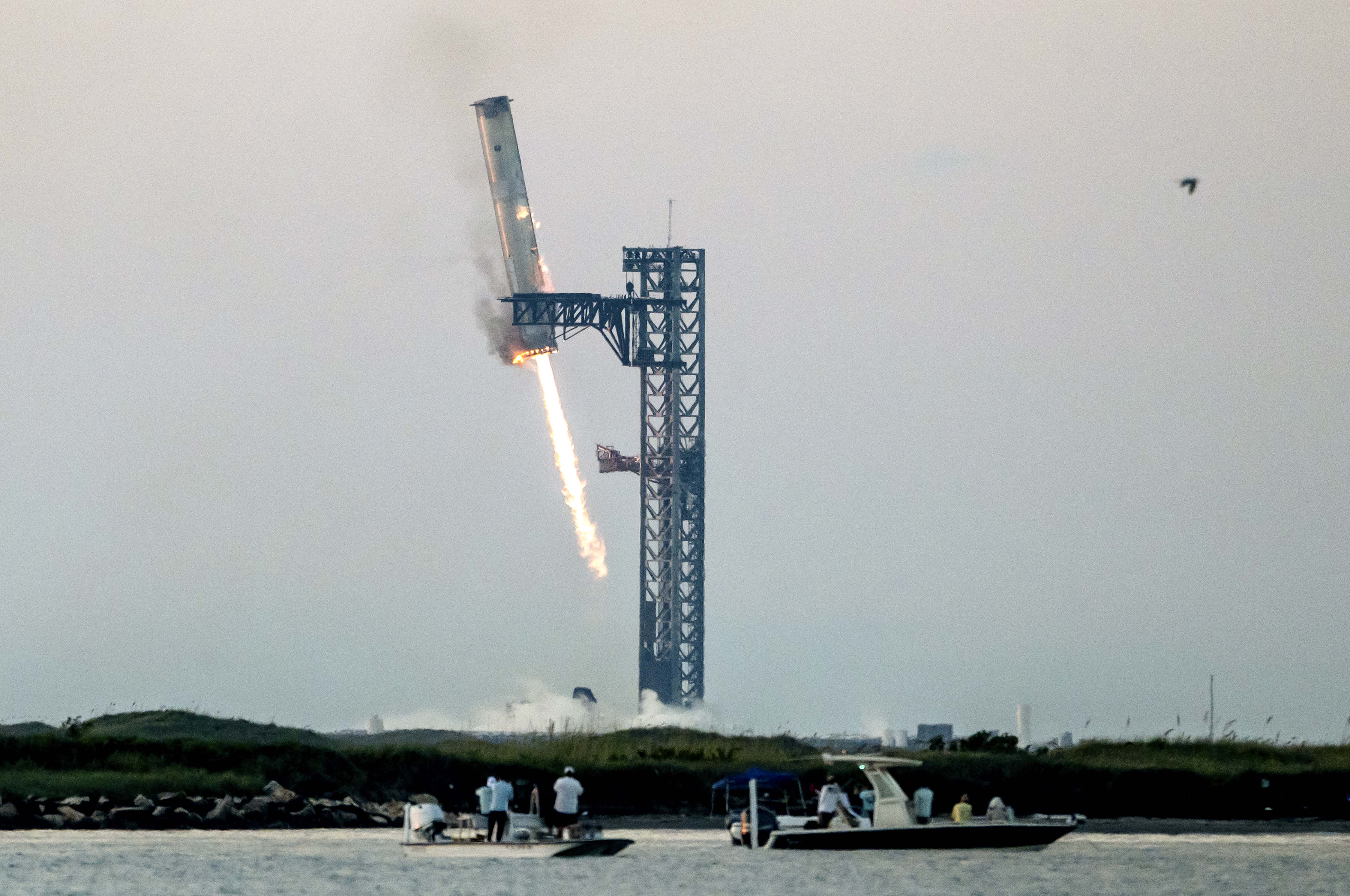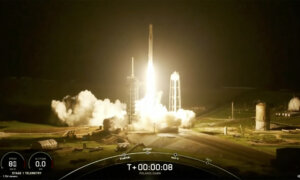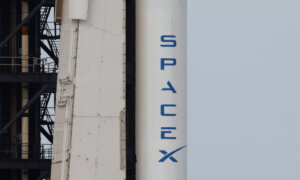SpaceX, in its fifth Starship test flight on Oct. 13, caught its returning giant booster back at the launch pad with mechanical arms.
The rocket’s first stage “Super Heavy” booster lifted off at 7:25 a.m. CDT from SpaceX’s Boca Chica, Texas, launch facilities, sending the Starship second-stage rocket toward space before separating at an altitude of roughly 40 miles to begin its return to land—the most daring part of the test flight.
The Super Heavy booster relit three of its 33 Raptor engines to slow its speedy descent back to SpaceX’s launch site, as it targeted the launch pad and tower it had blasted off from. The tower, taller than the Statue of Liberty at more than 400 feet, is fitted with two large metal arms at the top.
With its engines roaring, the 233-foot-tall Super Heavy booster descended into the launch tower’s enclosing arms, hooking itself in place with tiny, protruding bars under the four forward grid fins it had used to steer itself through the air.
“The tower has caught the rocket!!” CEO Elon Musk wrote on social media platform X, formerly known as Twitter, after the successful attempt.
SpaceX employees screamed in joy, jumping and pumping their fists into the air. NASA joined in the celebration, with Administrator Bill Nelson sending congratulations.
Continued testing of Starship will prepare the nation for the landing of astronauts at the moon’s south pole, Nelson noted. NASA’s new Artemis program is the follow-up to Apollo, which put 12 men on the moon more than a half-century ago.
The novel catch-landing method marked the latest advance in SpaceX’s test-to-failure development campaign for a fully reusable rocket designed to loft more cargo into orbit, ferry humans to the moon for NASA, and eventually reach Mars—the ultimate destination envisioned by Musk.

Starship's Super Heavy Booster is grappled at the launch pad in Starbase, near Boca Chica, Texas, on Oct. 13, 2024, during the Starship Flight 5 test. (Sergio Flores/AFP via Getty Images)
Starship, the rocket system’s second stage or top half, launched by the booster, continued around the world, soaring more than 130 miles high. An hour after liftoff, it made a controlled landing in the Indian Ocean, adding to the day’s achievements. Cameras on a nearby buoy showed flames shooting up from the water as the spacecraft impacted precisely at the targeted spot and sank, as planned.
SpaceX announced on Oct. 12 that it was going ahead with its ambitious Starship rocket test flight after being given the green light by air safety regulators.
The Federal Aviation Administration (FAA), which grants licenses for rocket launches and reentries, approved the SpaceX test mission on Oct. 12. Shortly after, SpaceX announced on X that it was preparing to launch the Starship on the morning of Oct. 13, as a “30-minute launch window opens at 7:00 a.m. CT.”
In the previous test in June, the vehicle achieved its first full test mission around the globe without losing either the Starship craft or its Super Heavy rocket boosters. The Super Heavy stage reached its mission targets, plunging into the Gulf of Mexico’s waters shortly after takeoff after a successful separation from the Starship, which then engaged its own engines to blast farther into space.
The Starship made a controlled “soft landing” in the Indian Ocean as planned, Musk said at the time, “despite loss of many tiles and a damaged flap.”
The Starship’s fourth flight lasted about one hour.
For the fifth test flight, the Starship has received key upgrades in the form of a complete rework of its heat shield.
“SpaceX technicians [spent] more than 12,000 hours replacing the entire thermal protection system with newer-generation tiles, a backup ablative layer, and additional protections between the flap structures,” the company stated. “This massive effort, along with updates to the ship’s operations and software for reentry and landing burn, will look to improve upon the previous flight and bring Starship to a soft splashdown at the target area in the Indian Ocean.”

SpaceX's Starship lifts off during its fifth flight test, in Boca Chica, Texas, on Oct. 13, 2024. (Kaylee Greenlee Beal/Reuters)
FAA Delays
Despite earlier delays, the FAA’s Oct. 12 approval was issued sooner than expected. The regulator had previously told SpaceX that its launch license wouldn’t be granted until late November because of changes to Starship’s flight profile that needed a “more in-depth review” involving other agencies that would need to be consulted about the flight’s environmental impact.SpaceX criticized the agency, saying that the inefficient process for government paperwork and “superfluous environmental analysis” for rocket launches “directly threatens America’s position as the leader in space.” It stated that it has been ready for its fifth test flight since the first week of August.
“This will be a singularly novel operation in the history of rocketry,” the company stated of the plans for the fifth test in September.
“SpaceX goes to the maximum extent possible on every flight to ensure that while we are accepting risk to our own hardware, we accept no compromises when it comes to ensuring public safety.”
Starship-Super Heavy’s first two test flights in April 2023 and November 2023 ended in explosions of both stages. The first failed test left a crater in the pad at Boca Chica Beach and the resulting explosion hurled debris, including concrete, for thousands of feet. The third test in March “made it to space,” improving on the company’s previous milestones, but the Starship was lost upon return as SpaceX lost contact with the spaceship as it neared the Indian Ocean.

SpaceX's next-generation Starship spacecraft, atop its powerful Super Heavy rocket, lifts off on its third launch from the company's Boca Chica launchpad on an uncrewed test flight near Brownsville, Texas, on March 14, 2024. (Cheney Orr/Reuters)
NASA already has two Starships on order, with plans to land astronauts on the moon later this decade as part of its Artemis program. Each moon crew will rely on NASA’s own rocket and capsule to leave Earth, but meet up with Starship in lunar orbit for a return ride back to Earth.
Musk says he plans for the Starship to eventually replace the company’s workhorse; the reusable, two-stage Falcon 9 rocket. SpaceX’s launch business already lofts most of the world’s satellites and other commercial payloads into space.
Reuters and The Associated Press contributed to this report.














